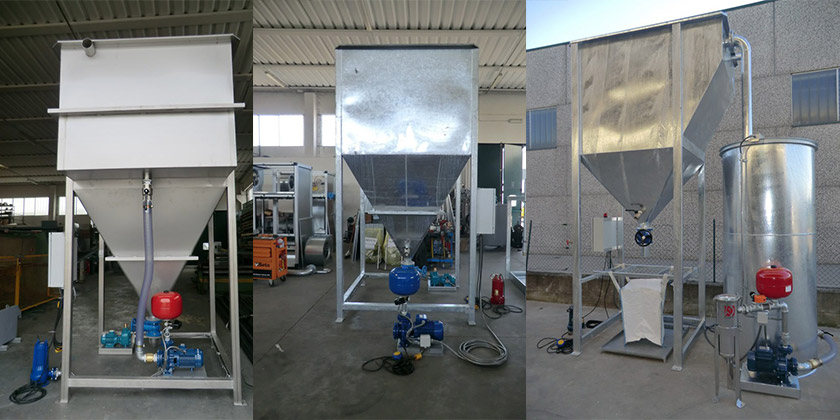Lamella Filtration for Stone Fabrication
Filter Project offers compact separation machines for fabrication professionals looking for units with a small footprint. These kinds of separators are great for fabrication shops that want effective sludge processing while taking up less space than larger sedimentation systems.
Construction of Lamella Seperation Units
A lamella separation unit is a water clarifier that separates stone particles from the water used in your shop. Furthermore, these water clarifiers filter out stone particles by routing water, slurry and sludge through a series of components. Additionally, clarified water goes to a storage tank or into another phase of processing. How you use the clarified water will determine where you send the water after this process. This lamella separator water clarification diagram shows the overall process the lamella style water clarifiers use.
Each part of the process contributes to the overall clarification of the water as it passes through the machine. First, let’s look at each part of the process and describe how it contributes to the clarification process. Then, we will talk about the particles and how the process affects them.
Lamellar Inlet Channel
Every stone water clarification process starts somewhere. Hence, the lamellar separation process begins with the inlet channel. This is where the influent that comes form your shop enters the system. The enters the system through the inlet. Then, the slurry systematically moves through the clarification unit. After entering the clarifier the slurry begins its trip through the lamella packs.
Lamella Packs
Once the particles and water are inside the filtration system they flow across lamellar packs. The water flows upward through the packs. While the water makes its way up to the top of the container, the particles drift downward as gravity acts on them because of their weight. Meanwhile, the particles settle toward the bottom of the tank. Then they enter the next phase of the process, the sludge funnel.
Sludge Funnel
The sludge funnel is the next stop as gravity pulls the particles toward the bottom of the chamber. As a result, the funnel collects the unwanted particles. As they gather, they form a compact sludge handled by another part of the process. Water from which the particles have been separated is sent to another area. We will talk about that aspect of the process next.
The Outlet Channel
This is simply the place where the effluent (treated water) exits the system. Then, the water gets disposed of or reused in the shop by fabricators using a variety of equipment such as:
- Hand Polishers
- Wet Bridge Saws
- Coring Machines
- CNC Machines
How Particles Are Affected
The water that enters this kind of clarification system actually contains 3 different types of particles. They are:
- Suspended Particles
- Colloids
- Molecules
The first particle to note are suspended particles. These are the largest of the three particles and are the ones that settle (allowing the separation) most readily. Hence, these particles move downward by gravity alone because of their weight.
The second particle type are the colloids. Smaller particles too small and light to settle, are “coaxed” along, so to speak. A coagulant and/or flocculant is used to cause the partiles to come together. The coagulant prepares the colloids by destabilizing them and the flocculant causes the colloidal particles to “gather”, or “come together” into larger particles. After the particles combine, they are thus heavy enough to settle to the bottom much like the suspended particles.
Finally, there are the very tiny particles; the molecules. These particles can be chemically filtered if there is a need.
Particle Settleing Rates
There are a number of factors that impact the rate at which the particles to settle through the lamellar packs to the next stage of the clarification process. Some of these factors include:
- The Weight of the Particle
- The Particle’s Shape
- The Size of the Particles
- The Frictional Resistance of the Particles
These factors are the most influential on the colloids. As a result, coagulation processes and flocculant units are often introduced to prepare the influent for its trip through the clarification plant.
In conclusion, these kinds of water filtration systems are compact and low maintenance because of their simplicity. Filter Project USA has an entire category dedicated to these types of units. Here are the links to the individual systems using the lamellar system:
- Stone Fabrication Water Clarifier
- Water Clarification for Granite Shops
- Compact Water Treatment for Stone
- Compact Water Filtering for Granite


One thought on “Lamellar Clarification”
Comments are closed.